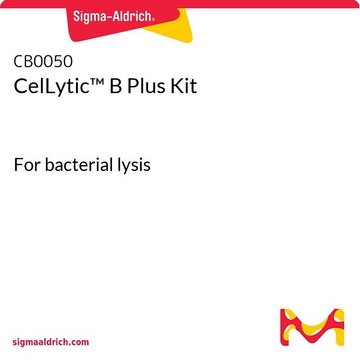P8849
Protease Inhibitor Cocktail
DMSO solution, for the inhibition of serine, cysteine, aspartic, aminopeptidases and thermolysin-like activities, for use in purification of Histidine-tagged proteins, DMSO solution
Sinônimo(s):
Protease inhibitor solution
About This Item
Produtos recomendados
product name
Coquetel Inibidor de Protease, for use in purification of Histidine-tagged proteins, DMSO solution
fonte biológica
synthetic
Nível de qualidade
forma
DMSO solution
temperatura de armazenamento
−20°C
Procurando produtos similares? Visita Guia de comparação de produtos
Descrição geral
The cocktail contains a mixture of inhibitors that specifically target serine, cysteine, aspartic, and thermolysin-like proteases, and aminopeptidases.
Especificidade
Aplicação
It is recommended for inhibition of protease activity in 100 mL of cell lysate from 20 g of Escherichia coli or 10 g of baculovirus-infected Spodoptera frugiperda pupal ovary cells.
Características e benefícios
Targets multiple types of proteases, ensuring comprehensive inhibition of protease activity.
Compatibility with IMAC applications due to omission of chelating agents.
Supplied in convenient packaging options.
Componentes
Bestatin
E-64
Pepstatin A
Phosphoramidon
Quantidade
This protease inhibitor cocktail has been optimized and tested for histidine-tagged proteins
Nota de preparo
produto relacionado
Código de classe de armazenamento
10 - Combustible liquids
Classe de risco de água (WGK)
WGK 1
Ponto de fulgor (°F)
185.0 °F - closed cup
Ponto de fulgor (°C)
85 °C - closed cup
Certificados de análise (COA)
Busque Certificados de análise (COA) digitando o Número do Lote do produto. Os números de lote e remessa podem ser encontrados no rótulo de um produto após a palavra “Lot” ou “Batch”.
Já possui este produto?
Encontre a documentação dos produtos que você adquiriu recentemente na biblioteca de documentos.
Os clientes também visualizaram
Nossa equipe de cientistas tem experiência em todas as áreas de pesquisa, incluindo Life Sciences, ciência de materiais, síntese química, cromatografia, química analítica e muitas outras.
Entre em contato com a assistência técnica














